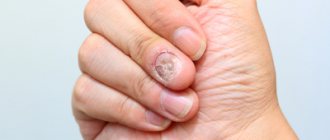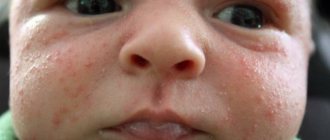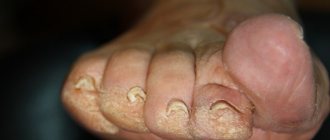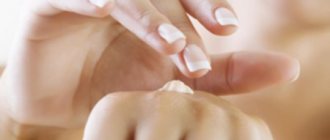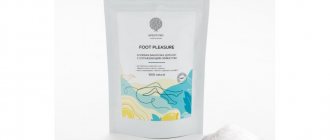The appearance of any skin defect can be perceived negatively by a person and cause a large number of unpleasant symptoms. This disadvantage especially concerns women who pay attention to the appearance of the slightest acne.
When pimples on the body itch, this is a reason to start sounding the alarm and contact specialists for appropriate medical help.
There are a large number of reasons for the occurrence of such unpleasant sensations. In addition to external irritants, the occurrence of an itchy feeling on the body can be a symptom of other more complex types of disease and require urgent treatment.
Eczema51
Eczema is a chronic allergic skin disease, which is characterized by the appearance of a polymorphic rash, acute inflammation, and itching.
The acute stage of the disease is characterized by the appearance of edema, erythema, against which vesicles, serous crusts, and punctate erosions with weeping are formed; papules and pustules with sterile contents are less often formed. If the pimples on the hands itch, this may indicate dyshidrotic and pruriginous eczema. So, with dyshidrotic eczema, the skin of the palms may become covered with itchy blisters and velculi. Pruriginous eczema is characterized by the appearance of small papulovesicles, mainly formed on the face and elbows, which can also cause itching.
Eczema develops due to neuroendocrine disorders, genetic predisposition, vegetative-vascular, metabolic, infectious and allergic factors.
Folk remedies
Along with the main treatment, you can use your grandmother’s recipes. For example, use aloe or celandine against herpes. You need to squeeze out the plant juice, moisten a gauze bandage with it, apply it to the affected area, cover it with cellophane, bandage it and leave it overnight. You can also prepare a healing solution from 4 drops of bergamot oil, 2 drops of tea tree oil and 1 tsp. alcohol Use this product to lubricate blistering rashes 2 times a day.
A bath with the addition of chamomile decoction helps relieve itching from chickenpox. To prepare it, adhere to the following proportions: 100 g of raw materials per 1 liter of boiling water. Chamomile should be brewed, strained and added to bathing water. Take a bath in the morning and evening. If you mix chamomile, lemon balm and calendula in equal parts, you can prepare an infusion for oral administration. You need to pour 1 tbsp of boiling water over a glass. l. vegetable mixture and leave for 15 minutes. The volume of liquid obtained after filtering is divided into 3 times and drunk warm during the day.
Urticaria is treated with nettle decoction. It is prepared like this: 200 g of chopped herbs are poured into 5 liters of water and boiled over low heat for 5 minutes. Then remove the broth from the heat and let it brew for 30 minutes. After filtering, 2 liters are poured and added to the bathtub. The procedure is repeated morning and evening, for 3-7 days, until the rash disappears. Another remedy is celery root. You should chop the root vegetable and squeeze out the juice. Drink it 4 times a day, 1 tbsp. l., and the paste is applied as a compress to the sore spot.
For those who suffer from dyshidrosis, a recipe made from blackberry leaves will help. It is prepared as follows: 100 g of crushed raw materials are infused in 2 liters of boiling water. The resulting product is used to wipe the affected areas several times a day. Sea buckthorn oil is also used to treat watery acne. It has remarkable antiseptic, softening and wound-healing properties.
For vesicular rashes of various origins, you can use lotions from freshly squeezed juices of agave, potatoes, and pumpkins. A gauze napkin soaked with them is applied to the pimples, fixed with adhesive tape and left for half an hour.
Scabies51
If small pimples on the arm are itchy, this may indicate that a person has scabies. This is a common parasitic skin disease that is caused by the scabies mite (Sarcoptes scabiei). Considering the daily rhythm of parasite activity, it can be explained why itching intensifies in the evening and at night. Among the methods of infection, direct contact with a sick person or infected objects predominates.
Localization of the disease: bends of the arms and legs, folds between the fingers, elbows, axillary cavities, wrist joints, abdomen, etc.
The clinical picture is often dominated by follicular papules (small pimples on the arms and torso), non-inflammatory vesicles near the passages, scratches and crusts.
Rash on a child's legs and arms
RASHE IN A CHILD ON THE LEGS AND HANDS WITHOUT FEMPERATURE, WITH FEMERATURE, ITCHES, DOES NOT ITCH
Children are the most beloved, defenseless people. The health of the baby sometimes depends on adults. They need our attention first. Children's skin is still imperfect and very susceptible to various infections. Thus, the appearance of a rash on the arms and legs may be an innocent manifestation, or it may be a signal of a dangerous disease. Below we will consider why a rash may appear in a child and how to act in this situation.
Rash - what is it?
What is this phenomenon? A rash is a pathological change in the skin and mucous membranes that differs from normal skin in appearance, structure, and color. It can be primary or secondary, that is, appear at the site of previous rashes. The combination of primary and secondary elements determines the picture of the rash in the disease. This may be a reaction to some allergen, or it may turn out that the rash is a sign of some disease.
Kinds
It turns out that rashes come in different natures and types. Primary and secondary rashes are distinguished. This is what a rash happens on a child’s legs and arms:
- The tubercles do not have a cavity, are located deep in the dermis, up to 1 cm in diameter. At the same time, the color and texture of the skin is different. They can leave scars and develop into ulcers.
- Blisters are without a cavity, have blurry outlines and are pink in color. Appear due to swelling of the papillary dermis. They pass without a trace, they itch.
- Papules or nodules - do not have a cavity. They may or may not be inflamed and their color has changed. They pass without leaving a trace
- Bubbles - have a bottom, a tire, a cavity. Once they are opened, erosion can occur.
- Pustules or pustules have pus inside. May be superficial or deep.
- Roseola appears as irregularly shaped pink spots. When the skin is stretched, the stain disappears.
If the rash appears again, then the following may form:
- Scarring.
- Abrasions.
- Cracks.
- Scales.
- Erosion.
- Ulcers.
Diagnostics
If a rash appears on your child’s legs and arms, you should urgently seek help from a pediatrician and dermatologist. First, the doctor should carefully examine:
- View.
- Form.
- Color.
- Quantity.
- The nature of the rash.
- The location of the rash is also important.
Next it turns out:
- Presence or absence of fever.
- What infectious diseases have you suffered?
- What hereditary diseases are there?
- Tendency to allergies.
- Photosensitivity.
As a rule, a rash is not the underlying disease, but is a symptom of some disease. It is a sign that a malfunction has occurred in the body. To determine the cause of this manifestation, the doctor prescribes tests. First of all, a blood and urine test. It is also possible to analyze the secretion of ulcers. After examination and analysis, the doctor prescribes treatment. What could be the reasons why a child has a rash on his legs and arms?
Sources of the problem
For a child’s body, a rash is a very important symptom of certain diseases, so consulting a doctor is important. The reasons for this may be the following:
- Allergic diseases.
- Infectious.
- Parasitic infections.
- Vascular and blood diseases.
- Violations of hygiene rules.
If the rash accompanies an infectious disease, the body temperature will certainly increase. There are other signs, these could be:
- Cough.
- Rhinitis.
- A sore throat.
Let's look at some diseases that are accompanied, in addition to a rash, also by fever.
Rash with fever
When an infection enters the body, its first reaction is fever. Skin rashes can appear with or without fever. There are several infectious diseases, the symptom of which is a rash.
This group includes:
- Chicken pox.
- Rubella.
- Scarlet fever.
- Measles.
- Enterovirus infection.
- Meningococcemia.
Each disease has its own characteristics of the spread of rashes. This is especially true for childhood diseases. Let's look at which of them cause a rash on the child's legs and arms, as well as on the body and face.
Chickenpox
This disease occurs most often in children. There are no vaccinations for it. The first sign of this disease is the appearance of red spots, which very quickly turn into blisters. In addition to blisters on the face, head, and body, the child also has a rash on the legs and arms. The temperature is elevated, and the baby may experience weakness and headache for some time.
If the blister is torn off, scars remain. The main problem of this disease is that the rash on the child’s arms and legs itches, and there is a risk of infection. The doctor may prescribe medications to relieve itching.
Rubella
This disease occurs with elevated temperature. In older children, joint pain and general intoxication are possible. Rashes appear on the 1st day or on the second day. First - on the face, neck, torso, then a small rash spreads on the child’s arms and legs, mainly on the folds. The younger the child, the milder this disease occurs. However, in adolescents, complications such as encephalitis and meningoencephalitis are possible. This disease is especially dangerous for pregnant women; fetal developmental defects are possible. Vaccination is also prohibited for immunocompromised patients. However, rubella is milder than scarlet fever.
Measles
A dangerous infectious disease, easily transmitted through the air with minor contact with a carrier of the infection.
There is a vaccine against measles. This disease is accompanied by intoxication of the body. Symptoms characteristic of a cold are present - coughing, watery eyes, sneezing. The temperature rises to high values. The rash begins from the mucous membrane of the cheeks, then moves to the face, the entire torso, and limbs (in the form of papules rising above the skin). Dangerous complications on the bronchi, can cause pneumonia.
Scarlet fever
This is an infectious disease transmitted by airborne droplets, through dirty hands and objects. It starts with a sore throat and chills. Then a small rash appears on the child’s arms and legs with fever. Most often in the bends of the arms and legs. The rash then spreads to the face, neck, and torso. The source of the rash is streptococcus. The throat begins to hurt, which is very similar to a viral infection. The main thing for definition is language. It will be raspberry in color. As soon as the temperature begins to decrease, lamellar peeling of the skin of the hands and feet begins. With this disease, it is very important to maintain bed rest and drink fluids. Antibiotics are required for treatment. Complications to the heart and kidneys are possible.
Enterovirus infection
Preschool children are susceptible to these diseases. A rash appears on the child’s legs and arms without fever. It usually doesn't itch
The child may be healthy or there may be a slight increase in temperature within one or two days. This occurs due to imperfections and sensitivity of children's skin.
Meningococcemia
This is a very dangerous disease. The temperature rises to high levels in a short period of time. A rash appears on the child’s legs and arms (it does not itch) in the form of irregularly shaped hemorrhage, and is also present on the buttocks. If such rashes are detected, you should urgently call a doctor and admit the child to intensive care.
Hemorrhagic vasculitis
This disease is characterized by a rash on the child’s arms and legs with fever, mainly in the area of the folds. At first, small blisters or lumps appear, then the rash turns red, acquires the color of rust, and disappears completely. It is believed that the disease can be caused by allergies, trauma, or be a consequence of acute infectious diseases such as tonsillitis, pharyngitis. Accompanied by fever and joint pain. With the lightning-fast course of this disease, death is possible. It is necessary to pay careful attention to treatment.
Non-infectious rash with itching
There are a number of diseases in which the rashes are very itchy. For example, with scabies, a rash appears on a child’s legs and arms without fever, most often on the folds between the fingers. As a rule, it itches a lot, especially at night. Also, with helminthiasis, the rashes itch
The presence of fungus on the skin of children is one of the causes of rashes in the form of blisters, erosions, and red spots. The localization of the fungus is usually on the legs, palms, feet, and wrists. The rash spreads especially quickly on moist areas of the skin. Can be easily transmitted through contact with a contaminated object. Infections occur especially often in places where there is a damp environment (shower, bathroom). The disease is accompanied by severe itching without fever.
Small rash without itching
If a small rash appears on the child’s arms and legs and does not itch, pseudotuberculosis may be at the initial stage of development. This disease is transmitted by rodents - after contact with things to which they had access. This disease appears very rarely in children, but it still exists.
If a child was born with congenital syphilis or was infected in utero, the rash may appear from time to time without bothering him. These are papules with a pustular core. Such rashes are not accompanied by itching and fever. Also, a small rash can be the result of a hereditary infectious disease such as psoriasis. In children under 2 years of age it is rare, but at an older age the risk of development, due to heredity, is quite possible. It begins with a small rash in the form of dry plaques of round and oval shape, red-pink in color, with noticeable peeling on top. It spreads over large areas of the skin, in the area of the knees, elbows, and head - this is a characteristic sign of psoriasis. This rash does not itch. In infants it can appear and go away, and in adulthood it can return again.
Allergic reaction
With allergic dermatitis, in addition to rashes on the face and torso, the child may have a rash on the legs and arms. The photos clearly demonstrate the manifestation of an allergic reaction. Rashes can be present either on a small area of skin or on a large one. As a rule, accompanying symptoms are peeling and severe itching. The body temperature remains within normal limits, and no intoxication of the body occurs. This reaction is possible to food, household chemicals, and medications. If a child has allergies, you need to be extremely careful with allergens and exclude them from the diet if possible, as there is a risk of angioedema. Possible respiratory arrest and laryngeal swelling.
Hives - a small rash - can be a reaction to temperature factors, cold, or sun.
What not to do if a rash is detected in a child
First of all, it is strictly prohibited in situations where you see rashes on your baby’s body:
- Squeeze out pustules.
- Pop bubbles.
- Treat with brilliant green or other means until examined by a doctor.
- Self-medicate.
If the rash on your child's arms and legs itches, do not let him scratch it. If a rash is detected, you should limit contact with others, as the disease may be contagious. As we saw earlier, a rash can be an important symptom or result of a disease. An examination by a doctor is required to make a correct diagnosis and prescribe appropriate treatment to eliminate possible complications.
Therapy
Treatment of rashes is, first of all, elimination of the disease that caused them. For infectious diseases, it is recommended to adhere to bed rest, take antipyretics, antihistamines, and treat rashes. If necessary, antibiotics are prescribed (to avoid the development of side effects). Allergy sufferers should definitely see an allergist. It is necessary to exclude allergens from your diet. You should also follow your doctor’s instructions and take antihistamines or glucocorticosteroids. In case of fungal diseases or scabies, observation by a dermatologist is necessary.
Rash prevention
The skin in childhood is not yet adapted to the manifestations of the external environment, so it requires special attention and care. First of all, it is necessary to observe the rules of hygiene. Parents should ensure that all necessary vaccinations against dangerous diseases are received. If your baby suffers from allergies, be sure to see an allergist. Proper treatment and observation will help the child outgrow this difficult period. Eliminate allergens from your baby's diet. Strengthen your child’s immunity so that he can fight diseases easily and without consequences.
Do not leave any rash, even a minor one, unattended!
Allergic contact dermatitis51
One of the most common causes of pimples on the hands is allergic contact dermatitis (ACD). It is an inflammatory reaction of the skin that occurs in response to external irritants. Occurs in a sensitized organism. Inflammation in ACD is a manifestation of delayed-acting hypersensitivity, which manifests itself 10-15 days after contact with the allergen.
ACD can be caused by contact with the following substances:
- metals;
- adhesives;
- cosmetics;
- external medications;
- dyes;
- chemicals, for example, rubber, cement, etc.;
- food products (in case of contact with skin);
- plants.
The rashes are located not only in the place that was exposed to the irritant, but also in other areas. In addition to the rash, patients may notice other subjective manifestations: itching, burning, pain. It is imperative to visit a dermatologist.
Why does a vesicular rash appear?
Watery acne on the body occurs for various reasons. Often their formation is associated with a viral or bacterial infection. The appearance of a rash can be caused by:
- hives;
- prickly heat;
- chicken pox;
- sunburn;
- shingles;
- eczema;
- mycoses;
- herpes;
- scabies mite;
- dyshidrosis
Vesicles can appear on the body as a result of hormonal imbalance. Many women face such troubles and rashes of various types during pregnancy.
In some cases, the cause of the rash lies on the surface and you can determine its origin on your own, in others you cannot do without the help of a doctor and appropriate tests. It is necessary to visit a pediatrician/general practitioner or dermatologist.
Acne31
Acne is a chronic inflammatory disease of the sebaceous glands, which manifests itself in the formation of closed and open comedones, inflammatory elements - pustules, papules, nodules. Most often, acne appears in the so-called seborrheic zones, where the density of the sebaceous glands is approximately 400 - 900 per cm2. This is the face (forehead, chin, nose), scalp, back. Acne also appears in the décolleté area and upper arms.
There are several degrees of acne severity. There is no clear classification, but in Russian practice the division into mild, moderate, and severe degrees of acne is often used.
Clinically, acne manifests itself in the form of closed (black dots) and open (small white rash) comedones, papules (red inflamed pimples), pustules (papules with purulent contents). With severe acne, nodules and cysts may appear.
Forecast and preventive measures
To prevent the occurrence of itchy acne, the following preventive measures must be observed:
- Maintain body hygiene;
- Take vitamin complexes;
- To live an active lifestyle;
- Use insect repellents;
- Regularly clean up the premises;
- Reduce contact with infected people;
- Be regularly examined by specialists.
If left untreated, a person may have the following complications:
- The appearance of scars on the body;
- Damage to healthy areas of the body;
- The need to use antibiotics to eliminate acne;
- Reduced protective functions of the skin;
- Exacerbation of the disease and transition to more complex types of skin lesions.
Azelik® is a drug for acne
Only a specialist can understand whether red pimples on the hands are a manifestation of acne or another disease. Therefore, in case of rashes, you should consult a dermatologist. One of the drugs that can be prescribed for mild to moderate acne is Azelik®.
The main component of Azelik® gel is azelaic acid. The foundation also includes an additional component - the emollient squalane, which helps moisturize and soften the skin. The drug has the following properties5:
- normalizes keratinization in follicles;
- has an antimicrobial effect, reducing the colonization of propionibacteria and Staphylococcus epidermidis;
- reduces the concentration of free fatty acids;
- has an anti-inflammatory effect by reducing the metabolism of neutrophils and the free forms of oxygen they produce.
Azelik® must be used twice a day5. Visible effect is usually observed after 4 weeks of use5.
Drug therapy for watery acne
Since blistering rashes occur with many different diseases, there is no single treatment system for them. Only a specialized specialist is able to correctly assess the patient’s condition and prescribe appropriate medications. Usually, when herpesvirus infections become more active, the doctor prescribes antiviral drugs:
- Acyclovir;
- Zovirax;
- Panavir;
- Valtrex and others.
For mycoses, antifungal agents are prescribed. First, the dermatologist takes scrapings—samples of damaged skin for microscopic examination. Having determined the culture of the fungus, he selects effective antimycotics. These can be ointments for topical use - Clotrimazole, Fluconazole, Exoderil, Terbinafine, Ciclopirox. In advanced cases, heavy artillery is added - antimycotics for internal use, often containing the same active ingredient as in external preparations.
For diseases that are included in the group of contact dermatitis, antihistamines are indicated. These are Suprastin, Erius, Zyrtec, Cetrin. Ointments and gels, such as Psilo-balm and Fenistil, are used externally. It is also necessary to exclude the allergen that causes an exacerbation of the pathology.
Watery pimples with chickenpox are treated with fucorcin, brilliant green, chlorhexidine, and a solution of potassium permanganate. Dyshidrosis is treated with antiseptic, anti-inflammatory drugs, using Atropine Sulfate, Furosemide, zinc ointment.

